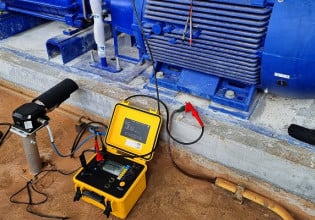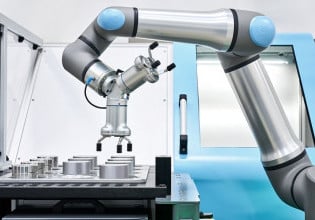Ethernet Ports on Controllers: How Many, and What do They Do?
Some controllers and network devices have one port, while others have two. Why is there a difference, and what advantages does having two network ports actually provide?
When designing an automation system, either as a new package or as an upgrade from an existing system, automation engineers must balance additional capability with cost and added complexity. One piece of this puzzle is determining how many ports are necessary and how to address them from a communication standpoint.
This article is geared towards comparing the three most common Ethernet options for controllers and network modules. This doesn’t include switches, which are a completely separate category of network devices.
One Ethernet Port
The simplest of all of the options is to have one port, which, by definition, will only have one configurable address. With the one port, one address system, controllers will have a direct connection to the device. It is simple, fast, and a little easier to troubleshoot. The lower cost and reduced complexity make it an attractive option for equipment that will require little to no change over time.
The major disadvantage of a one-port system is that they are difficult to expand. If more devices are required, one must also install a switch, which will cost both time and money to integrate. Also, there is no redundancy.
Consider the situation where network communication is lost. It might be a physical problem with one of the ports on either end of the Ethernet cable. With a two-port system, the cable (or a new cable) can be switched to the other port and tested. With a single-port system, this test is not possible, and other methods must be used.

Figure 1. Two otherwise quite similar CPUs, differentiated in the number of network ports. In this case (the Productivity P1-550), the second port, called Remote I/O, is preconfigured for Modbus TCP on a separate network.
Two Ports with One Configuration
This option is based on devices that have a built-in network switch. It is a bit of a compromise between the one-port system and the two-port system, allowing multiple devices to be connected, but only addressable through one port. This makes network segmentation possible, which means traffic can be physically segregated.
Consider a piece of equipment that has a data stream for archiving and troubleshooting purposes and a command stream where control commands are issued. With a two-port system, these two streams of information can be segregated. By placing the remote data server on one port, while the connection to the plant floor exits on the other port, a more logical separation can be created. However, both networks still share the same connection, and security may be a risk factor.
Device Level Ring (DLR)
Another major advantage of two shared ports is the security of redundancy. A network concept called device level ring (DLR) provides all devices in the network with two traffic routes to all other devices, in one big daisy-chained loop. If any of these cables fail or become disconnected, all devices maintain a connection with all others.

Figure 2. A device level ring, or DLR, diagram illustrates how if a single branch loses connection (like the red line near the top, breaking a cable), all nodes can still communicate. Image used courtesy of HMS Networks
The internal network switch adds a layer of complexity, and as with all network switches, it must be a little slower. Even though there are multiple devices, only one can be accessed at a time. For high-speed applications, this could become a problem, as the time delay during switching means equipment is moving without control for those fractions of a second while communication to the other device is occurring.
Two Ports with Individual Addresses
The most complex yet most expandable and scalable system is one with two ports and two separate, programmable IP addresses. With this system, each port can act as a gateway between subnets, meaning the system can be expanded to add even more components as manufacturing needs at the plant change. By starting with this design, future integrations are performed more quickly, as some of the important design considerations, such as how to manage the entire network, security protocols, and rules, and so on, are addressed early in the design process.
The obvious disadvantages of this system are the initial costs and complexity. For smaller manufacturing operations, where there is no network specialist, a one-port, one-address system is easy for virtually any technician to set up and maintain. With added complexity, the need for specialized labor and training is required.
Considerations of Ethernet Port Selection
In order to decide how many ports should be implemented, one must consider not only the immediate installation expense, but the future expansion plans and the level of redundancy required. For systems that will be installed and left to run for many years, perhaps one-port hardware is all that is needed. However, if additional components may be added in the future, the cost of multiple ports may be justified in making future expansion easier to implement.

Figure 3. How many ports does this remote I/O Ethernet bus connector have? Well, if you know, you know, I guess.
It’s similar to the age-old question of whether to program from the top-down or the bottom-up. In automation, a top-down approach would be to design the automation system to include the ultimate goal in mind. This means designing to include all systems, features, and components, including some that may not be in the budget or even invented yet, into the initial design. It means adding complexity at the beginning when simplicity will do. The bottom-up approach would start with the simplest system and slowly add complexity as new components become available.
The top-down approach has the advantage of being forward-thinking, meaning new components can be quickly integrated. However, it is difficult to plan for what could be. This leads to overdesign, additional cost, and complexity. Instead of a fully functional, feature-laden automation system, the project risks being abandoned, compromised halfway or overly complex for its purposes in the initial stages.
The bottom-up approach has the advantage of only spending time and money on the immediate need. No additional complexity is added before its time; technicians working on these systems learn the new automation components when they are needed, versus learning lots of things all at once. The difficulty with the bottom-up approach is that each new component or system that gets added must be made to fit the whole system. When enough of these components get added, it is the physical embodiment of spaghetti code.
System Mindset and Network Design
Ultimately, the automation engineer must weigh the additional complexity and cost with the increased benefits of more ports and more addresses. While the question of “how many ports do I need?” may not seem like it relates to spaghetti code and overdesign, it can be an indication of the overall automation philosophy. As such, it is important to examine the strengths and weaknesses of both the top-down and bottom-up approaches to create the most robust automation system for the plant’s specific needs.







I enjoyed this article and found it to be very informative and insightful on the different types and application techniques of Ethernet ports, especially the part about the top-down, bottom-up approaches.